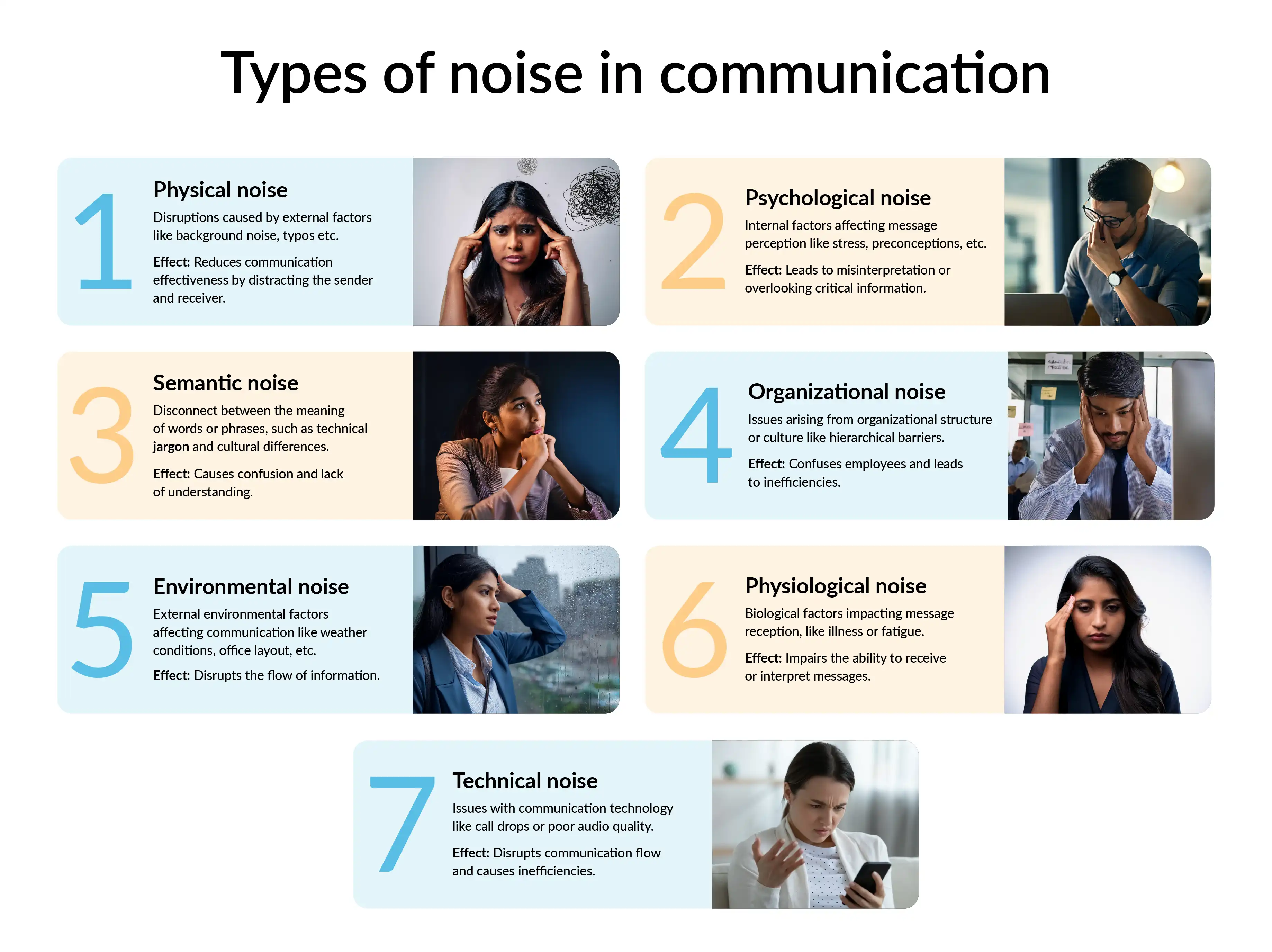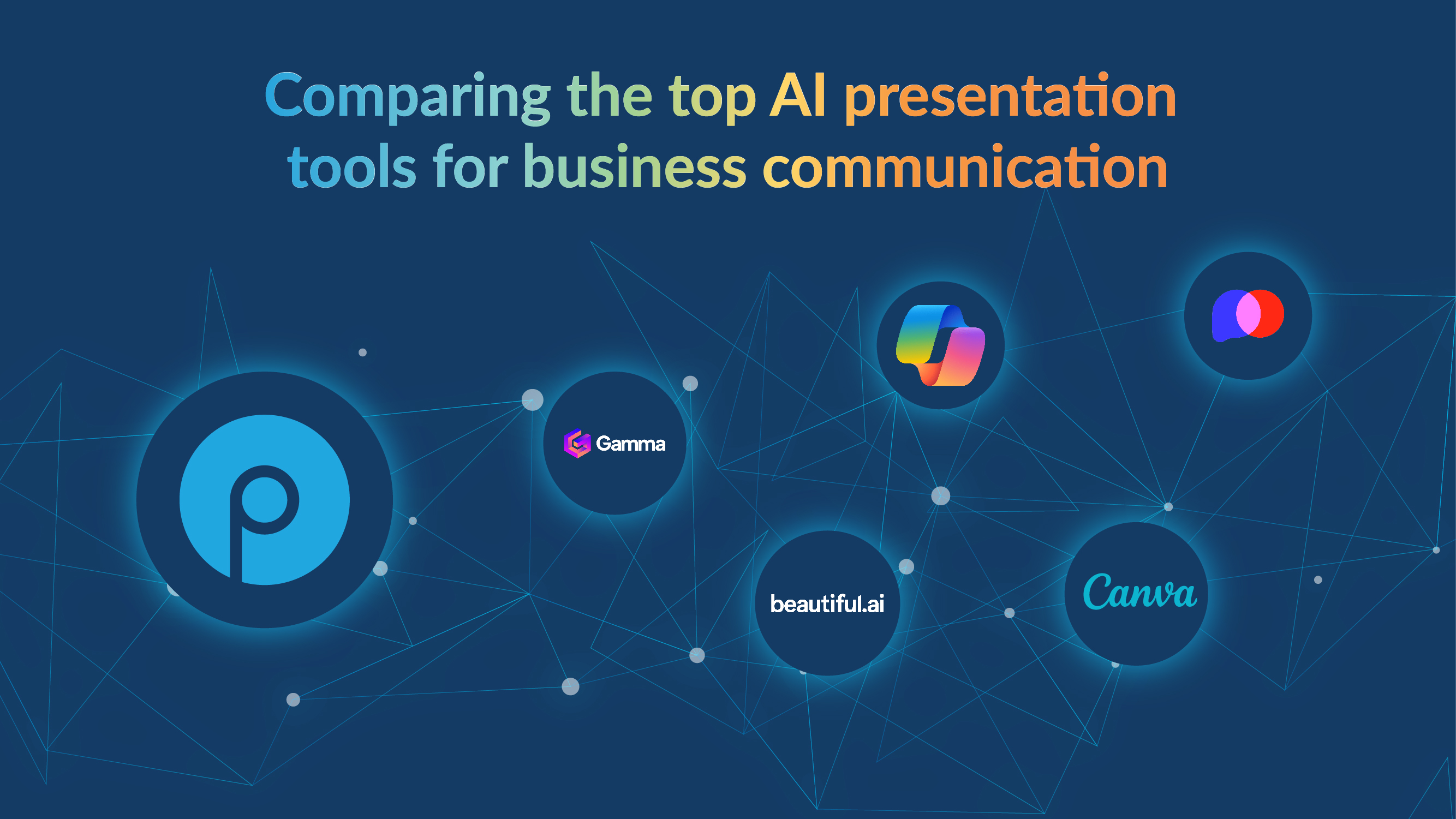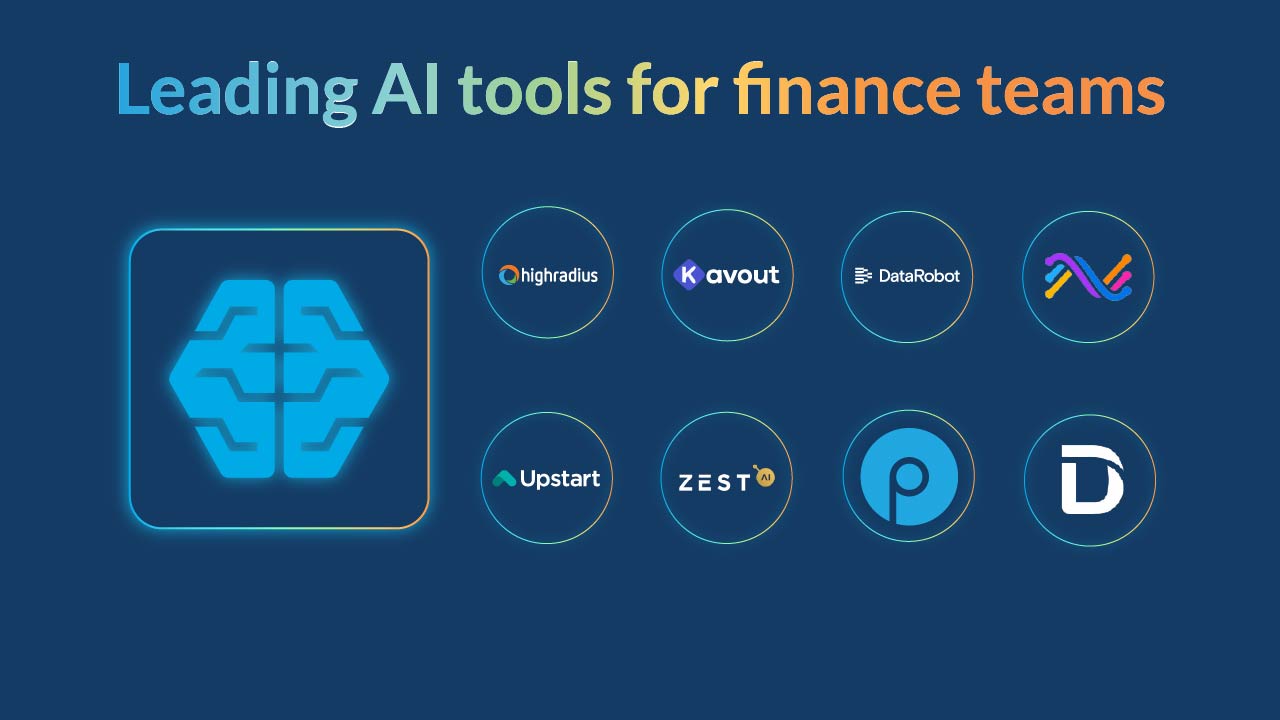Noise in communication: Types of noise, examples, and process

Consistent achievement of business goals and growth largely depends on how information is shared and understood. A slight misinformation or misinterpretation can cost an organization millions of dollars. Noise in communication is one significant contributor to obstruction in the transformation of messages. In this article, we will discuss noise in communication, explore the major types, and outline strategies to mitigate these issues for effective business communication.
What is communication noise?
Before we get into the details, let's first understand what noise is in communication. Noise refers to any disruption or interference that affects the message transmission, reception, or understanding.
For example, in remote working environments, you must have experienced network disruptions or slow internet, causing unclear audio or video during virtual meetings. Such issues hamper the clarity of the message and lead to misunderstandings or missed information. This can result in delayed actions or incorrect decisions, potentially causing significant financial losses to the firm.
How does noise cause communication barriers?
Noise in communication presents several challenges that can disturb the flow of information and hinder effective communication. Some of the main challenges caused by noise barriers include:
1. Misinterpretation of messages
Noise can lead to misunderstandings if the receiver misinterprets the message. This can result in incorrect actions, poor decisions, and even conflict within teams.
2. Reduced clarity
When noise interferes with communication, the clarity of the message diminishes. This lack of clarity in message can make it difficult for recipients to grasp the full meaning which can further lead to confusion and mistakes.
3. Increased frustration and stress
Frequent noise, whether physical, psychological, or technical, can cause frustration and stress among communicators. This emotional noise can further compound the problem, making effective communication even more difficult.
4. Delayed decision-making
Noise can have a profound effect on decision-making. Slowing down the communication process causes delays in the flow of information. This, in turn, can delay decision-making, potentially resulting in missed opportunities or prolonged project timelines. It can also result in wrong decision-making costing the firm heavily.
5. Decreased productivity
When communication is hampered by noise, it requires additional time and effort to clarify messages, resolve misunderstandings, and ensure the message is understood as intended. This can lead to decreased productivity.
6. Lowered engagement and morale
Constant communication noise can lead to disengagement among team members. If individuals feel that their messages are not accurately received or are constantly misunderstood, it can decrease morale and reduce overall team solidarity.
7. Inconsistent information flow
Noise causes discrepancies in the flow of information leading to inconsistent messaging across different stakeholders. This can create alignment issues, where different parts of the organization are working with conflicting or incomplete information.
8. Damages relationships and trust
Repeated communication breakdowns due to noise can hamper trust between individuals or teams. If messages are frequently misinterpreted or delayed, it can strain professional relationships, leading to a lack of confidence in communication channels.
Types of noise in communication
Noises come in various forms—some are audible and easily recognized, while others are non-auditory and more challenging to detect, yet both are capable of significantly disrupting the flow of communication. The different types of noises are listed below:
1. Physical noise-
Physical noise is disruption caused by external sources that interfere with communication process. In written communication, noise can appear in the form of poor formatting or typo errors. Examples of physical noise could be background sounds, poor lighting, or any physical barriers that hinder clear verbal communication. Such noises distract the sender and receiver of the message and reduce communication effectiveness.
2. Psychological noise-
Psychological noise results from internal factors that affect how a message is perceived and understood. This type of noise can include mostly psychological factors like preconceived notions, stress, or emotional states, causing individuals to misinterpret or overlook critical information. Psychological noise can also result in poor decision-making and stress the team dynamics.
3. Semantic noise-
Semantic noise occurs when there’s a disconnect between the sender and receiver regarding the meaning of words or phrases. This can happen due to jargon, technical language, or cultural differences in interpretation. For example, using complex technical terms in a meeting with non-technical people can lead to confusion and lack of understanding. Similarly, cross-cultural communication challenges, including nonverbal communication or differing interpretations of certain phrases, can contribute to semantic noise. This makes it difficult for the receiver to understand the intended message.
4. Organizational noise-
Organizational noise is specific to the structure and culture of an organization. This type of noise can arise from hierarchical barriers, unclear communication channels, or conflicting messages from different departments. For example, a company leader frequently changes the strategic direction without clear communication can end up confusing the employees about priorities, leading to inefficiencies and errors.
5. Environmental noise-
Environmental noise includes the broader external factors that affect communication. This can include weather conditions, such as a storm causing a power outage during a virtual meeting, or even the layout of an office space that inhibits collaboration. These environmental factors can disrupt the flow of information and create barriers to effective communication.
6. Physiological noise-
Physiological noise is due to biological factors, such as hearing impairments, fatigue, illness, or any other health condition that affects a person's ability to receive or interpret a message.
7. Technical noise-
Technical noise emerges due to issues with communication technology, such as software glitches, poor-quality audio or video connections, or hardware malfunctions. In remote work, technical noises are often experienced due to slow internet speed, dropped calls, or software bugs disrupting the flow of communication and leading to inefficiencies.

Steps to mitigate noise in communication:
Noise disrupts the communication process and makes it very hard for the professionals to work towards the organizational goals. While you cannot completely eliminate all noise, you can certainly take certain steps to reduce noise and manage it to ensure that messages are delivered and understood clearly. Some of the effective measures to help you overcome noise and improve communication are listed as under:
Awareness of noise sources
Identifying the source of noise will help you be aware of possible distractions during a conversation and take proactive measures to minimize the impact.
For example, if you have a headache before an important review meeting, you can take steps to either postpone the meeting or take medication to help you feel better so that you can be attentive during your discussion.
Know your audience
Tailoring your message as per your audience's needs, preferences and expectations helps them pay better attention to the message.
Knowing your audience also helps in preventing semantic noise, as you will be aware of their choice of language and level of technical knowledge. This ensures that your message is clear and relevant.
Active listening
Active listening is part of being aware of the existence of various noises. This practice helps you pay attention to understand the message completely. To practice active listening, you have to pay close attention, avoid interruptions, and ask relevant questions to understand the intended message clearly. Active listening helps recognize and address psychological and physiological noise that may otherwise distort the message.
Encoding clearly
Use clear and concise language to encode your ideas effectively. This means you have to avoid using jargon or technical terms that your audience might not understand. This helps reduce semantic noise and ensures your message is easily understood.
Use of feedback mechanisms
An active feedback mechanism during communication is important to ensure the message has been received and understood as intended. You can use simple practices like asking questions, summarizing key points, or requesting confirmation to identify any noise that may have interfered with the communication process. This practice also allows you to take immediate corrective actions to ensure message clarity.
Choosing the appropriate channel
Select the right communication channels in your organization to deliver the message to your intended audience. For example, complex or sensitive information should be better conveyed through face-to-face communication rather than email. Choosing the right channel helps you minimize technical and environmental noise as well.
Implementing communication tools
Leverage technology to mitigate physical, technical, and environmental noise. For example, using noise-canceling headphones during virtual meetings or soundproofed meeting rooms during face-to-face meetings can help you avoid physical and technical noises. Similarly, using collaboration tools like shared documents or project management platforms can help clarify communication and reduce organizational noise.
How does Prezent help in mitigating noise?
Prezent helps mitigate noise in business communication by offering tools and features designed to enhance message clarity, reduce misunderstandings, and establish an effective communication process:
- Streamlined content creation: Prezent provides over 35k slide templates and guided frameworks to help users structure their messages clearly and concisely. The storylines are constructed to enhance engagement, understanding, and retention of information. This reduces semantic noise by ensuring that complex ideas are communicated simply and effectively.
- Tailored communication: The platform allows users to customize presentations and messages based on the audience's needs and preferences. This helps in addressing psychological noise by ensuring that the content resonates with the audience and is easily understood.
- Collaborative tools: Prezent includes collaboration features that enable teams to work together seamlessly, reducing organizational noise. Shared presentations, real-time editing, and integrated feedback mechanisms ensure everyone is on the same page.
- Visual enhancements: Prezent equips you with a variety of visualization tools that help you convey complex data and ideas more effectively. The platform minimizes technical and semantic noise by using charts, graphs, and infographics, making the information more accessible and less prone to misinterpretation.
Noise in communication has been a constant challenge. With Prezent, we make business communication effective and efficient by streamlining the presentation creation process and providing guidance and training to the professionals to help them refine their communication skills.
Learn more about the capabilities and tools of Prezent by scheduling a demo at your convenience. You can also explore the platform yourself by opting for a free trial.













